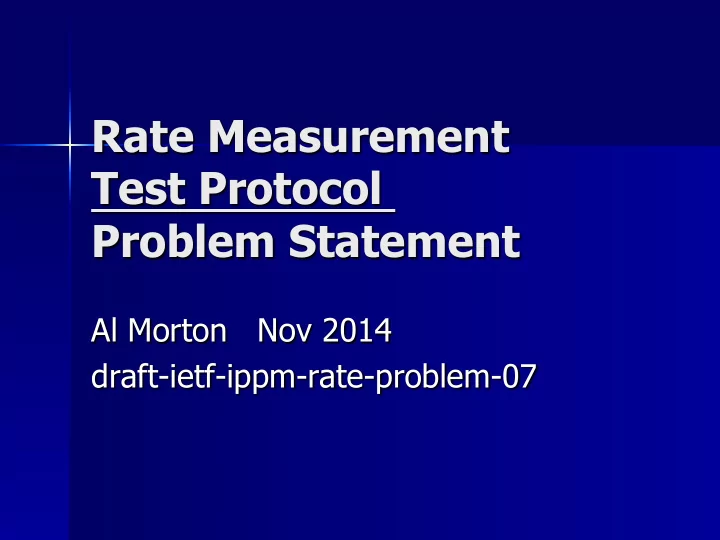

Rate Measurement Test Protocol Problem Statement Al Morton Nov 2014 draft-ietf-ippm-rate-problem-07
Scope n Access Rate Measurement on Production Networks – Rates at edge << core, likely bottleneck – Asymmetrical ingress and egress rates – Largest scale at edge: low complexity needed in device at user end – Tester has control of sender/receiver 2
Scope (contd.) n Access Rate Measurement on Production Networks – Active measurements (IPPM charter) – Both In-Service and Out-of-Service n Includes service commissioning activity n Non-Goals – No protocol solution in this draft – No Exact methods of meas (but categories discussed) 3
2013 Compromise: Sec 5 n Requirement for Asymmetric packet size control only – Sumita req. both – Symmetric size control and testing are commonplace, right? n Expanded the Requirement for BOTH Symmetric and Asymmetric Packet Size (this was agreed) n First WGLC, comment on Sec 5 4
Sec 5 Revisions (ver 06) n Toronto Compromise on Packet Generation Capability: – Asymmetrical RATE is REQUIRED – Asymmetrical SIZE is RECOMMENDED n RECOMMENDED means – There may exist valid reasons in particular circumstances to ignore a particular item, – but the full implications must be understood and carefully weighed before choosing a different course. 5
More Detail Two-way architectures are RECOMMENDED to include control and generation capability for both asymmetric and symmetric packet sizes, because packet size often matters in the scope of this problem and test systems SHOULD be equipped to detect directional size dependency through comparative measurements. 6
NEW: Asymmetric packet size control indicated when results depend on the size of the packets (1) n i.e. when any of the following conditions hold on a link in the path: – asymmetrical capacity in opposite directions (in combination with one or more of the conditions below, but their presence or specific details may be unknown to the tester) – which aggregates (or divides) packets into link- level frames, and may have a capacity that depends on packet size, rate, or timing, – <next slide> 7
NEW: Asymmetric packet size control indicated when results depend on the size of the packets (2) n i.e. when any of the following conditions hold on a link in the path: – where transmission in one direction influences performance in the opposite direction – transmission capacity depends on packet header processing capacity (IOW, the capacity is sensitive to packet size), – the target application stream is nominally MTU size packets in one direction vs. ACK stream in the other, (noting that there are a vanishing number of symmetrical-rate application streams 8
NEW: Asymmetric packet size control indicated when results depend on the size of the packets (3) n i.e. when any of the following conditions hold on a link in the path: – the distribution of packet losses is critical to rate assessment, n and possibly other circumstances revealed by measurements comparing streams with symmetrical size and asymmetrical size. n Implementations may support control and generation for only symmetric packet sizes when none of the above conditions hold. 9
Conclusion + Next Steps n If you are solving Rate Measurement Test Protocol problem differently, good4u. n You don’t need a lot of Test Protocol Support to do bit rate tests. n This Statement sets requirements for a widely applicable and sufficient solution. Of course, other requirement sets and solutions are possible. n draft-morton-ippm-twamp-rate-05 n draft-morton-ippm-twamp-tcp-00 10
backup 11
draft-ietf-ippm-lmap-path-00 Internet-Draft LMAP Reference Path July 2013 Subsc. -- Private -- Private -- Access -- Intra IP -- GRA -- Transit device Net #1 Net #2 Demarc. Access GW GRA GW mp000 mp100 mp150 mp190 mp200 ... Transit -- GRA -- Service -- Private -- Private -- Destination GRA GW GW Demarc. Net #n Net #n+1 Host mpX90 mp890 mp800 mp900 GRA = Globally Routable Address, GW = Gateway 12
Recommend
More recommend